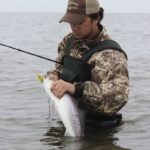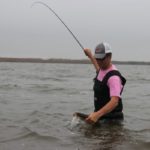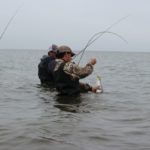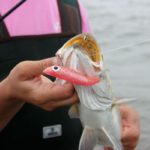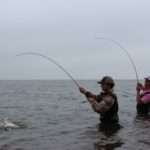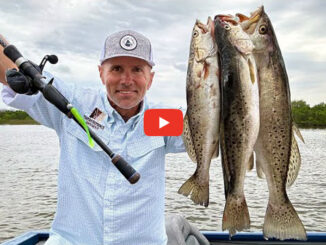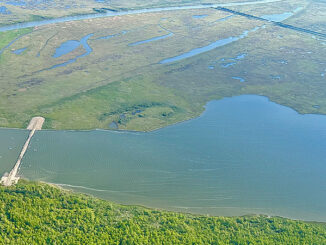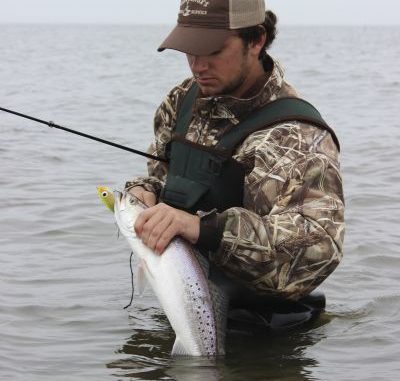
Calcasieu Lake and its cousin Sabine Lake are known for producing lunker trout, and there’s no better way to target these trophy fish than to abandon your boat. Here are some keys.
You won’t find too many speckled trout anglers who like wind. Wind muddies the water. Wind makes even simple things more difficult.
And wind can crush a man’s soul.
Early spring wind is the worst kind. Anglers itching to dust off the cobwebs of fishing boats and fishing baits are tantalized by tales of outsized trout eager to do a little of their own energizing following the winter doldrums.
But when it comes time to get on the water, spring can just plain stink much of the time. When the wind doesn’t blow, furious clouds of flying teeth (aka gnats or flying midges) swarm warm bodies with what seems like death of 10,000 bites.
When it blows, well, you know what happens.
An increasing number of enterprising anglers in the southwest portion of the state are choosing to embrace the wind in their spring pursuit of some of the state’s biggest specks.
Wade fishing is synonymous with summertime on the barrier islands, but to trophy trout connoisseurs of Calcasieu Lake and Sabine, spring is the time to get in the water.
“The fish are up shallow this time of year,” Capt. Scott Hanchey said. “Getting out of the boat is a very deliberate way to fish an area that might hold a lot of fish.”
Hanchey considers Calcasieu his home waters, but has increasingly put time in on Sabine as a back-up when Big Lake is off or reports from Sabine are good.
And the fish are not only shallow: They can be big.
Every year anglers fishing these two bodies of water catch trout approaching and exceeding 10 pounds. In a lake known for size, you’d be hard pressed to find a person who wouldn’t put March and April as one of if not the best months to catch a fish of a lifetime.
When the wind blows — which is most of the time — anglers like Hanchey adapt to it by slipping on waders, tying on some slow-sinking mullet imitators and getting their minds around the fact that jumping out of a perfectly good boat is not only a good strategy for catching fish but it’s really the only strategy that makes sense.
“When we have a calm day or I’m up against a protected bank, I’ll cast from the boat until I get bit,” Hanchey said. “But as soon as I do, I’m getting out of the boat and working over the area.
“And if it is blowing, I’m getting in as soon as I get there.”
Hanchey’s years of doing it this way has taught him that wading is strangely one of the most efficient and inefficient ways of probing a likely area.
“Lets just say you’ve got a big area that you want to fish,” he said. “There might be a nice school of, let’s say, 20 fish, maybe even big fish, schooled up loosely in one particular spot. If you’re in a boat and drifting, you might catch one or two if you’re lucky. But chances are by the time you get the boat stopped in the wind and the Power-Pole down and the waves are slapping, you’re most likely not going to get everything possible out of that school.
“Now if you’re wading along and you get a bite or you hang one, you stop, you make another cast. You can work over that school of fish. And that might be a pack of 4- to 6-pounders. But if you were in a boat, chances are you’re going to spook those fish or sail right over them.”
Conversely, if the goal is to cover a large swath of water, wading can be arduous. Even in the early spring chill, a bluebird day produces intense rays bouncing off the water into your face. The bottom, while significantly better suited for walking than the deltaic muck prevalent in other parts of the state, contains patches of mud that can be difficult to walk in. And continuing along the same unproductive path takes a healthy measure of blind faith after a while.
“There’s a trial and error when you’re first trying it to learn an area,” said Capt. Josh Berg, a fishing guide buddy of Hanchey. “On some good days you’ll see little slicks popping up: Fish that area, do well in it and come back the next time to fish it again.
“Sometimes there’s something to it on the bottom and sometimes it just seems like those fish were there randomly.
Berg indicated that there are drop-offs and little patches of shell in some of the areas they’ve uncovered, but there’s also just patches of shoreline that are better than others for no particular reason.
“It’s just a matter of putting your time on the water to find those spots,” he said.
One such location the duo found on Sabine Lake is a large flat that contains numerous grass clumps up to a quarter of a mile offshore, likely pushed or rolled off the bank by Hurricane Rita. It’s one of their most-productive areas in that it’s a wide-enough area of shallow enough water that two sets of anglers can set up on it and fish it without disturbing the other.
There’s not many such areas that he’s found in either lake, but they’re important in not only holding fish but keeping harmony among anglers fishing the same general area.
“You really want to give other fishermen a lot of room, especially this time of year when the big fish are up shallow,” Hanchey said. “Wading is not an easy, relaxing way to fish and this time of year is a time for the really big fish.
“You can ruin a guy’s day by cutting him off and trying to fish a stretch of shoreline right in front of him.”
Wading pays dividends in the way one can work the preferred type of bait for this time of year in Calcasieu and Sabine.
Topwater plugs can work when water temps make their way toward 70 degrees, but until then the irresistible slow fall of lures like MirrOlure’s Corkys dominate the wading scene.
And baits like the Corky and wade fishing are perfect companions.
“You can work your bait correctly when you’re out of the boat,” Hanchey said. “Everyone has a tendency to work it too fast when the wind is pushing the boat, and it doesn’t really give you an opportunity to hold your rod at the proper angle, either.”
Being in the water really maximizes the control an angler has over his lure.
“Confidence is an important thing in this type of fishing,” Hanchey said. “Sometimes we’re fishing long stretches without a bite, looking for that one big fish or that school of fish that I mentioned before. If you don’t think you’ve got good control over that bait to really work the water column and make it work like you want it to work, there’s much less chance you’re going to be successful.
“Being in the water and being able to be in good control of your location is something that can really make a difference.”
The proper rod technique for wade fishing with these lures includes two sharp twitches from 10 o’clock to 12 o’clock and then slowly dropping the rod as the slack is taken up while being careful not to disturb the bait’s descent.
Hanchey said following the lure as it sinks is critical to bowing up on any trout — much less a trophy — this time of year.
“I’d say 95 percent of the strikes come as the lure is falling,” Hanchey said. “You need to be able to feel the bite with as little slack as possible while not interfering with the fall.”
That makes sensitive rods and line important parts of the equation. Medium-light rods and 30-pound Sufix braided line with about 2 feet of 20-pound fluorocarbon leader are almost the universal choice.
The sensitivity of such limber rod tips serves the dual purpose of detecting strikes and providing a buffer between trophy fish and zero-stretch line.
The goal of a cast is to lob the bait as far as possible. Seventy-yard casts with the wind at one’s back are common, and anglers like Hanchey and Berg say it’s almost habit to reel in baits when they reach the halfway mark of a retrieve.
“You’ll find that you get a lot of your strikes at the top end of your cast,” said Berg, who like Hanchey guides on both Cacaisieu and Sabine. “When I’m doing this, I’m looking for the biggest fish out there. I’ve got it in my mind that the biggest fish is much more likely to bite the farther I am away from her.”
Hanchey added that retrieving the lure halfway in accomplishes the same goal as covering the entire length of the cast as long as you repeat the process over and over again.
“I feel like I’m getting the best chance of getting a bite when I’m working the bait the farthest away from anything that might spook a fish,” he said. “There are times when you’ll get a strike from a fish while burning it across the surface, but that’s not normal and mostly it’s not the size fish we’re looking for.”
When that happens, it could also be a signal for anglers to try topwaters. Water temperatures in the upper 60s is generally the sweet spot for getting blow-ups, but the region’s notoriously fickle, cold front-oriented weather sometimes makes it hard to choose one’s weapon.
“The water warms up a lot faster than most people think, especially when you get into March and April and the days get longer,” Hanchey said. “But when we get cold fronts a good bit into spring it’s hard to figure what they’re going to hit.”
Capt. Scott Hanchey of Bay Hippie Outfitters can be reached at 337-302-6232. Capt. Josh Berg can be reached at 337-526-2169.
